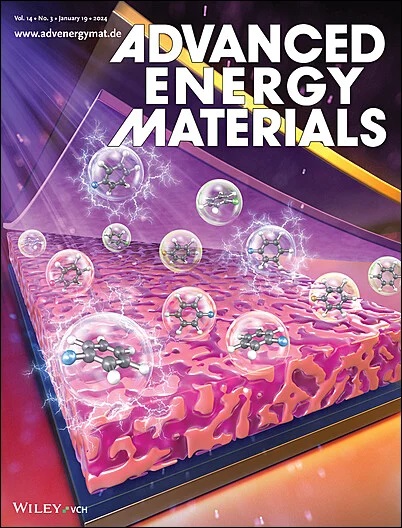微环境增强碳载体上痕量金属Pb在非水溶液中选择性电化学还原CO2为金属草酸盐
IF 24.4
1区 材料科学
Q1 CHEMISTRY, PHYSICAL
引用次数: 0
摘要
在这项工作中,通过将痕量金属铅(Pb)与聚合物覆盖层结合在碳基支架(CBS)上,可以将二氧化碳(CO2)电还原为草酸盐。这些复合材料作为一种高效的电催化系统,可以方便地转化和储存二氧化碳,这是一种有害的大气污染物。控制电位电解实验的结果表明:1)ppb尺度上的痕量金属Pb对CO2到草酸盐的还原偶联具有活性,其法拉第效率与块体金属Pb相当;2)这种痕量金属Pb的聚合物包封导致CO2还原(CO2R)选择性地促进了金属草酸盐的还原,而不是其他产物,如CO。金属草酸盐是重要的替代胶凝材料和其他材料合成的前驱体。固体产品经过严格的光谱表征,包括13CO2标记实验,以确保金属草酸盐实际上是由CO2R产生的。这些发现为利用微环境效应来提高碳利用和储存技术中微量金属催化剂的活性和选择性提供了模型。本文章由计算机程序翻译,如有差异,请以英文原文为准。

Selective Electrochemical Reduction of CO2 to Metal Oxalates in Nonaqueous Solutions Using Trace Metal Pb on Carbon Supports Enhanced by a Tailored Microenvironment
In this work, the electroreduction of carbon dioxide (CO2) to oxalate is enabled by incorporating trace metallic lead (Pb) on carbon-based supports (CBS) with polymer overlayers. These composite materials serve as an efficient electrocatalytic system for the facile conversion and storage of CO2, a pernicious atmospheric pollutant. Results from controlled potential electrolysis experiments indicate that 1) trace metallic Pb on the ppb scale is active toward the reductive coupling of CO2 to oxalate at comparable Faradaic efficiencies to bulk metallic Pb and 2) polymer encapsulation of this trace metallic Pb leads to promotion of CO2 reduction (CO2R) selectively to metal oxalates over other products such as CO. Importantly, metal oxalates are important alternative cementitious materials and precursors for other materials’ synthesis applications. The solid products undergo rigorous spectroscopic characterization, including 13CO2 labeling experiments, to ensure the metal oxalates are in fact produced from CO2R. These findings serve as a model for leveraging microenvironment effects to enhance activity and selectivity for CO2R using trace-metal catalysts for carbon utilization and storage technologies.
求助全文
通过发布文献求助,成功后即可免费获取论文全文。
去求助
来源期刊

Advanced Energy Materials
CHEMISTRY, PHYSICAL-ENERGY & FUELS
CiteScore
41.90
自引率
4.00%
发文量
889
审稿时长
1.4 months
期刊介绍:
Established in 2011, Advanced Energy Materials is an international, interdisciplinary, English-language journal that focuses on materials used in energy harvesting, conversion, and storage. It is regarded as a top-quality journal alongside Advanced Materials, Advanced Functional Materials, and Small.
With a 2022 Impact Factor of 27.8, Advanced Energy Materials is considered a prime source for the best energy-related research. The journal covers a wide range of topics in energy-related research, including organic and inorganic photovoltaics, batteries and supercapacitors, fuel cells, hydrogen generation and storage, thermoelectrics, water splitting and photocatalysis, solar fuels and thermosolar power, magnetocalorics, and piezoelectronics.
The readership of Advanced Energy Materials includes materials scientists, chemists, physicists, and engineers in both academia and industry. The journal is indexed in various databases and collections, such as Advanced Technologies & Aerospace Database, FIZ Karlsruhe, INSPEC (IET), Science Citation Index Expanded, Technology Collection, and Web of Science, among others.
 求助内容:
求助内容: 应助结果提醒方式:
应助结果提醒方式:


